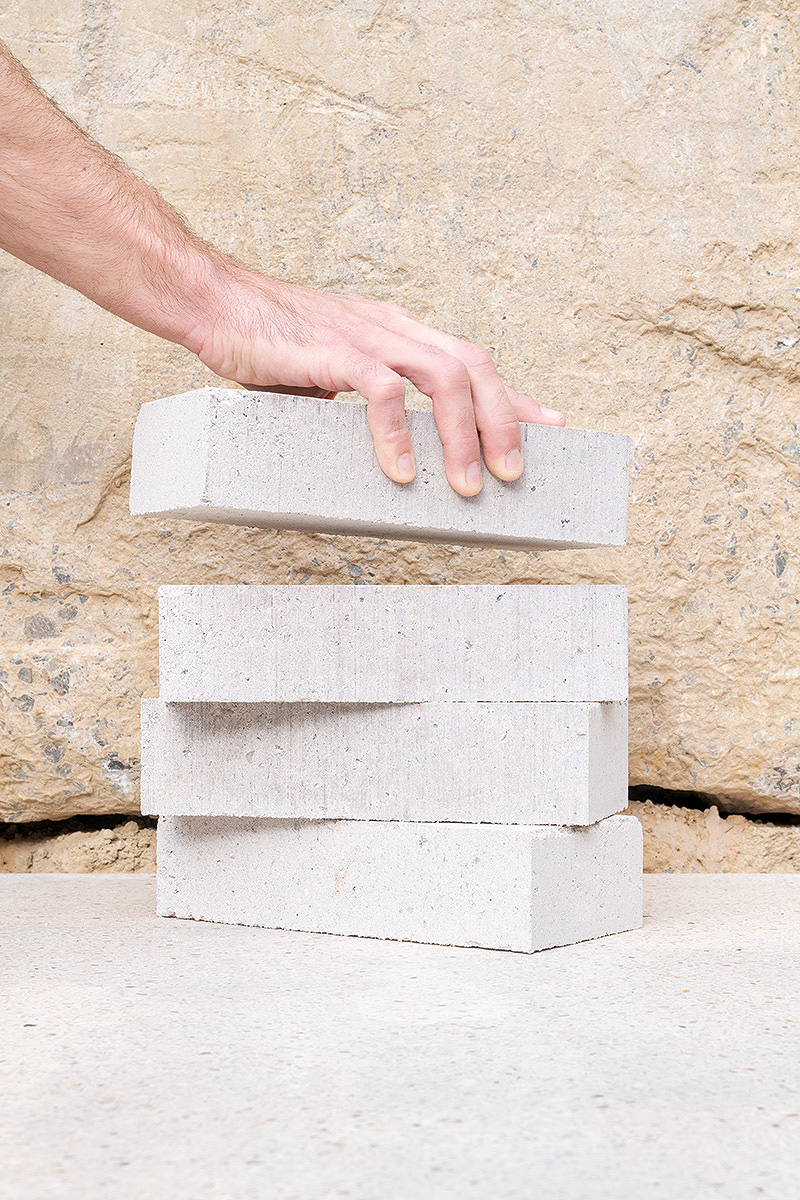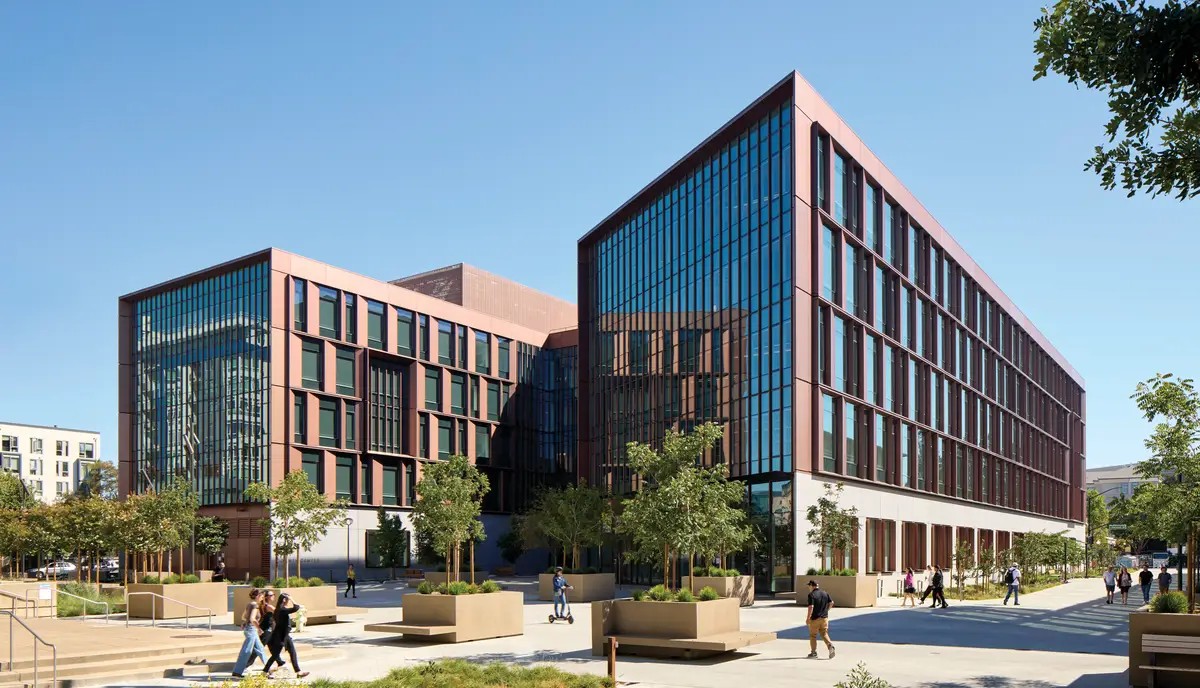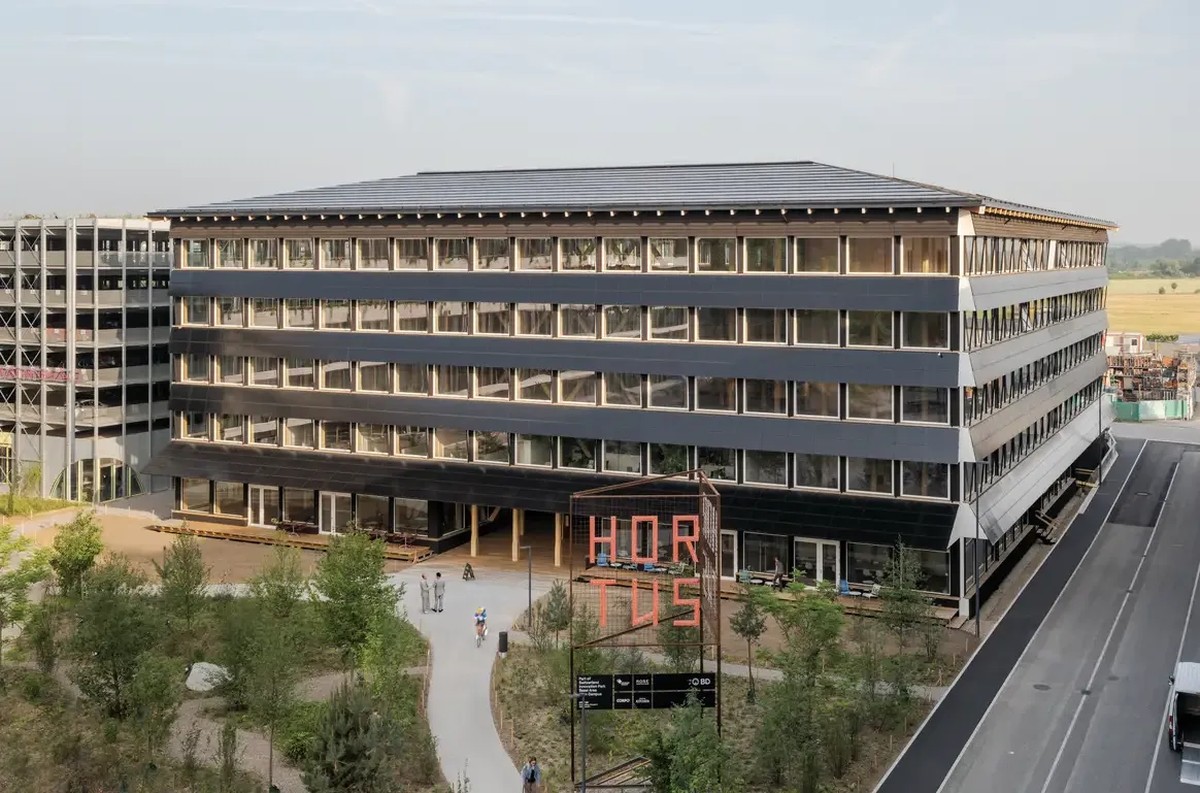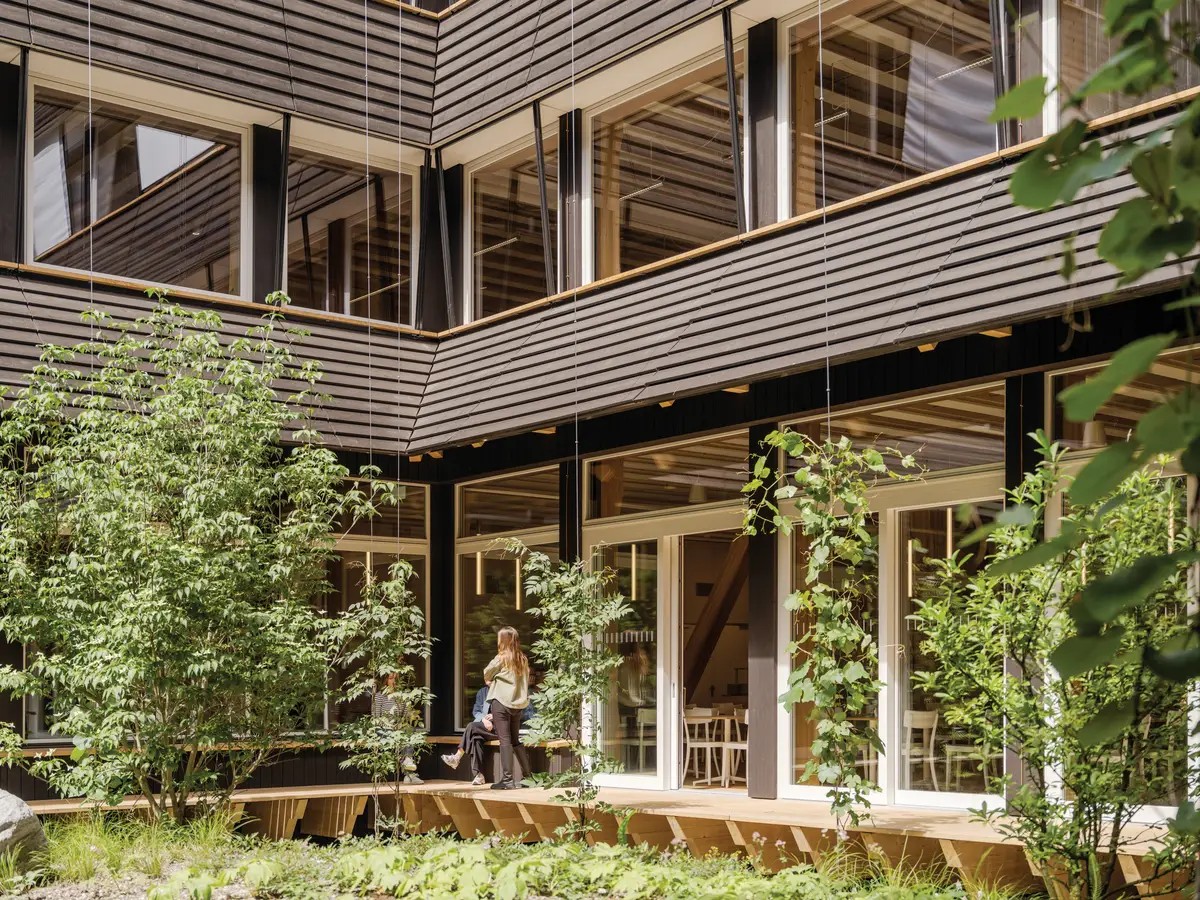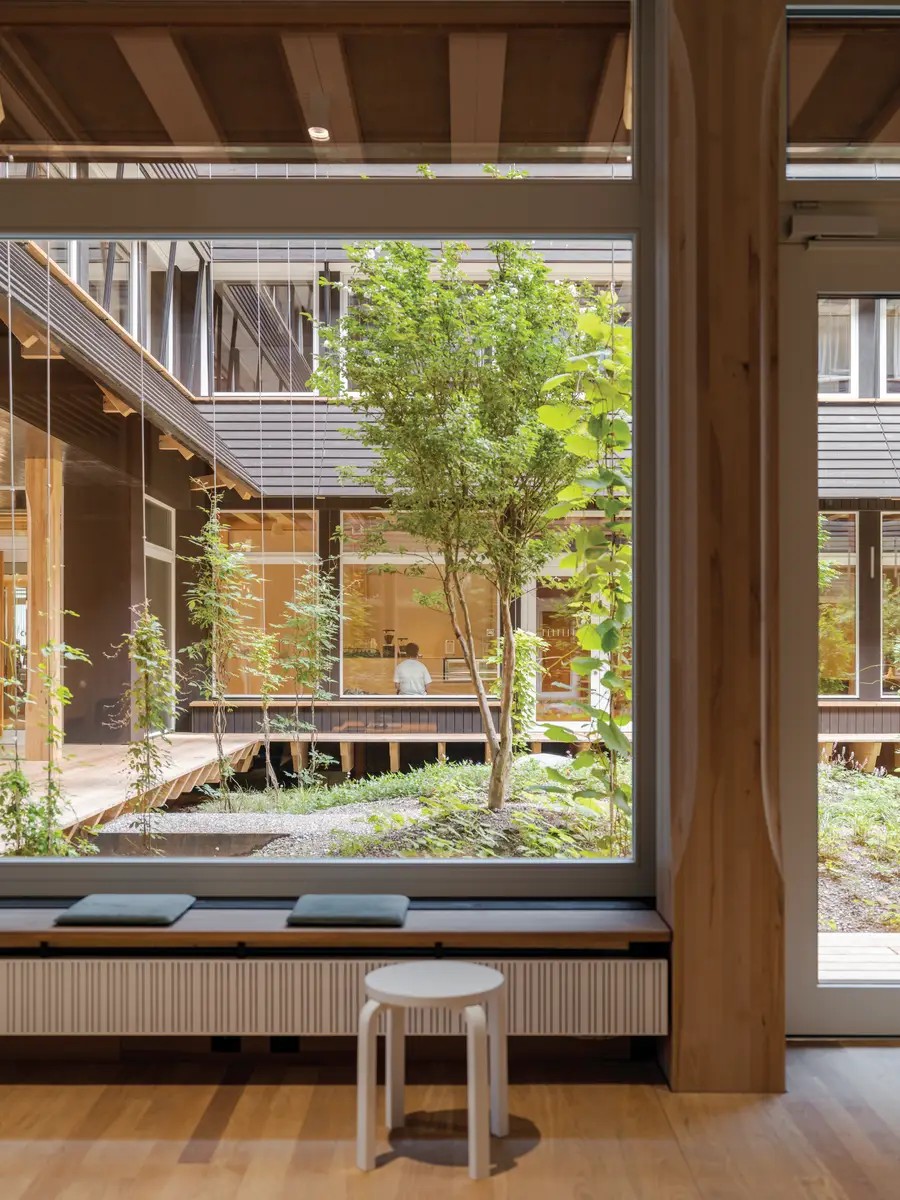This series covers wide-ranging strategies for a greener future, from circular and low-carbon materials and building adaptation to net zero energy and urban megadevelopments.
Photo © Romanin & Noceto
Waste brick developed for the Design Museum Gent by Carmody Groarke.
Select an article to read more.
By Tim Abrahams

Photo courtesy Carmody Groarke
Kevin Carmody (left) and Andy Groarke (right) founded their practice in 2006.
Although Kevin Carmody and Andy Groarke met during their time in David Chipperfield Architects’ London office in the early 2000s, they are more likely to cite one of his clients, Antony Gormley, as a mentor. While the pair were working on the sculptor’s new studio, he showed them how “materials take their form through processes and how these can determine the character of a project.” They founded their own practice in 2006, continuing to collaborate with Gormley thereafter on a range of works. Two other early projects embedded the importance of material lifespan in their subsequent work: Studio East Dining was a striking temporary restaurant at the heart of the emerging Olympics Park in 2010, made from building-site materials such as scaffolding boards and poles, which were returned to their original use after three weeks. By contrast, their memorial to the July 7 terrorist attacks in Hyde Park in London was made from stainless-steel cast vertical pillars and was built to last for 300 years.
Carmody Groarke is known in London for its stylish, low-budget adaptations of existing buildings, which give, says Groarke, “an experience of architecture through the way that it is made.” For example, the aluminum-clad extension of a simple warehouse in Bethnal Green, which mirrors the floors below, is a visual manifesto for reusing the city’s industrial structures imaginatively. However, the firm’s most interesting work has operated at the two extreme poles of lifespan established by its early projects. The Hill House Box is a temporary superstructure that protects Hill House, a key Charles Rennie Mackintosh work near Glasgow, that members of the public can access to closely view the historic building during restoration and renovation. The office has also been working on a long-term master plan for the British Library. record contributor Tim Abrahams speaks with Andy Groarke about the practice’s thoughtful approach to the life of construction materials.
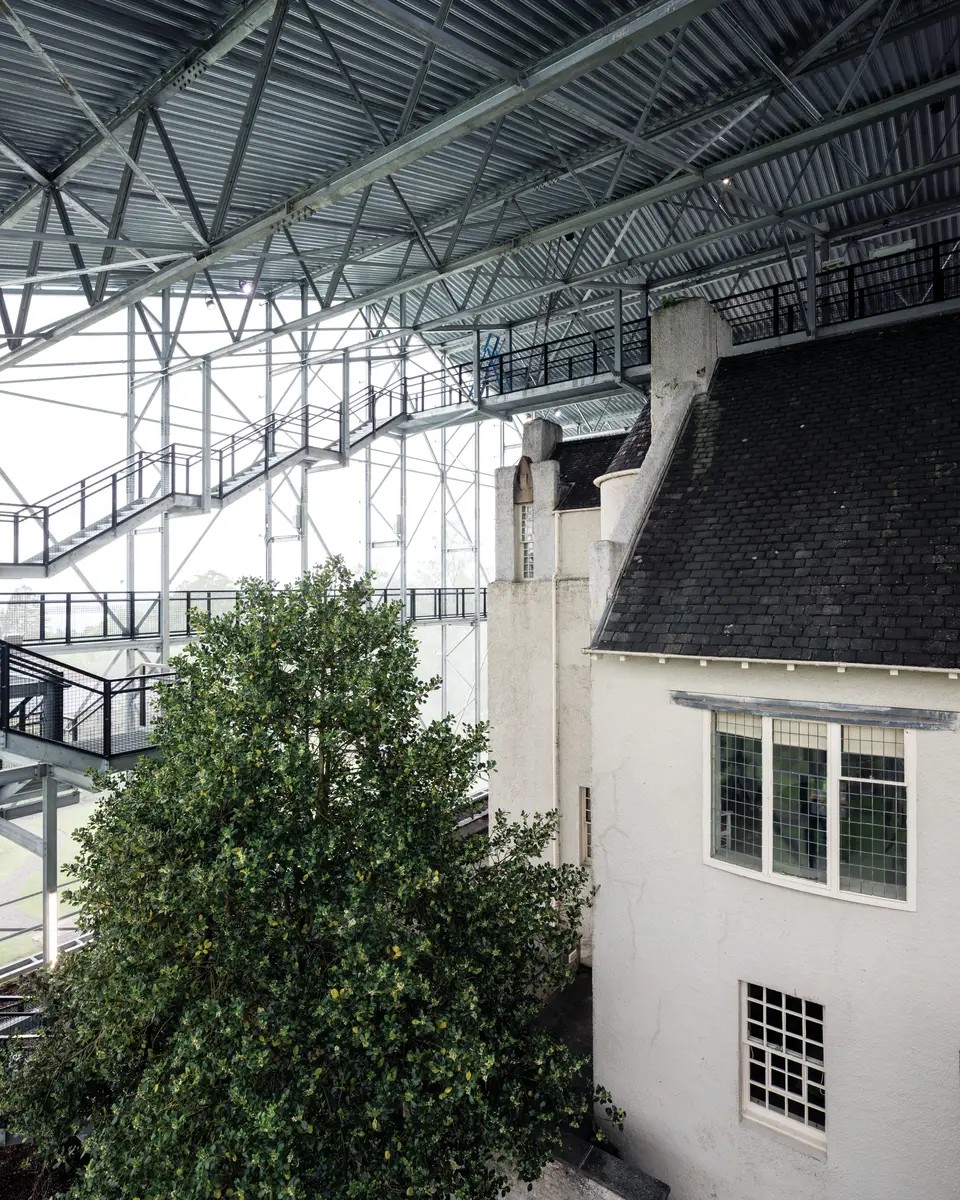
Photo © Johan Dehlin
Hill House Box is unusual in allowing visits by members of the public during active conservation as one of Charles Rennie Mackintosh’s most significant works is being restored.
Tell me about the new building at Boston Spa for the British Library, which is expected to be completed next summer.
Around 80 percent of the library’s collection is stored in Yorkshire, in buildings that were originally part of a WWII munitions plant. The last facility, built in the 1970s, used conventional architecture based on retrieving books off shelves by hand. The new building is a fully automated storage facility. In a single room the size of a soccer pitch and about 10 stories high, 8 million books will live.
Where is the architecture in such a building?
We thought about trying to find ways in which the architecture could help not only environmental sustainability, but the long-term institutional sustainability of the British Library by creating an archive building that was as passive as possible.
We are nearing completion, and the tests are telling us it’s one of the most airtight buildings in Europe, so we can neutralize risks to the collection by de-oxygenating the environment to the same air quality of Base Camp Two on Mount Everest—quite difficult to breathe in, but it almost eradicates the risk of fire. The environmental engineers have worked out that the collection itself can create thermal stability, meaning that the energy use of the building is only around 3 percent of the energy use of the last storage building the British Library built.
What is it like to be inside it?
You get this otherworldly space of robots and books at a scale that, at first sight, you can’t get your head around. We find that a tremendously interesting spectacle. Click here to read more....
The University of Oregon’s architecture program transforms a disused 1950s gym into its Portland home
By Randy Gragg
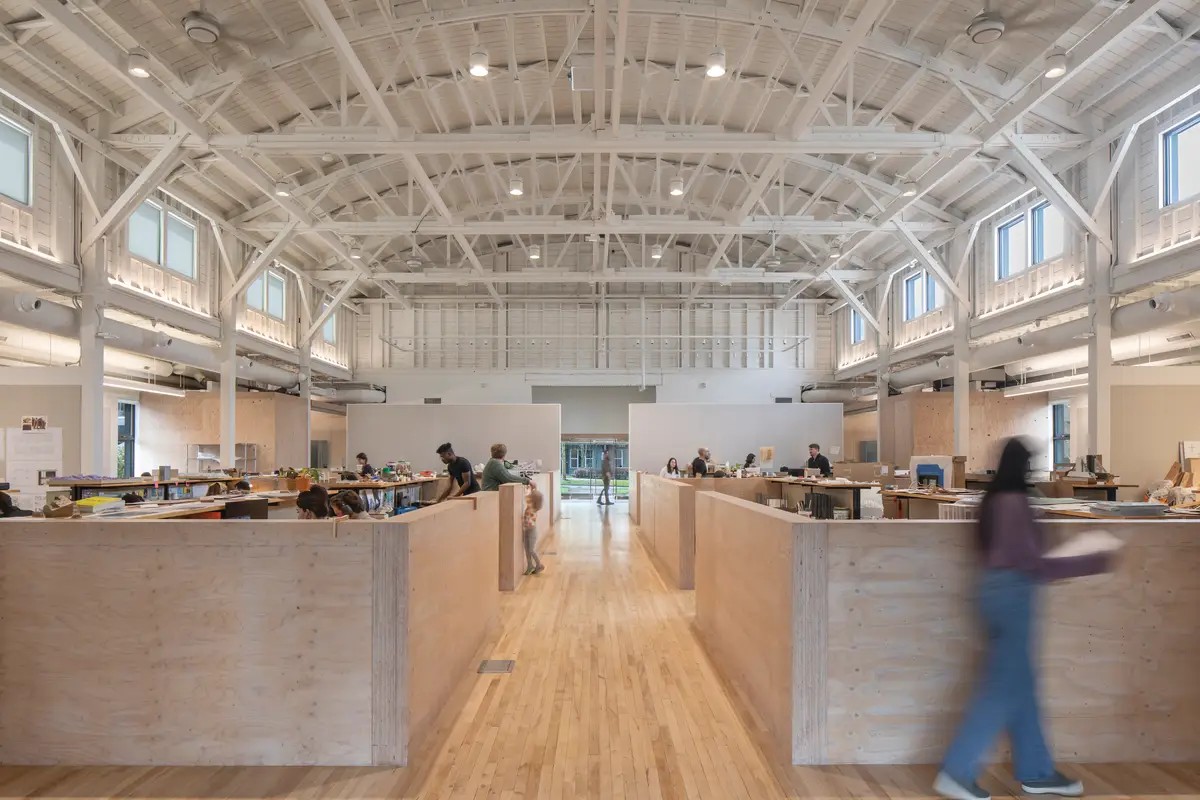
Photo © Lara Swimmer
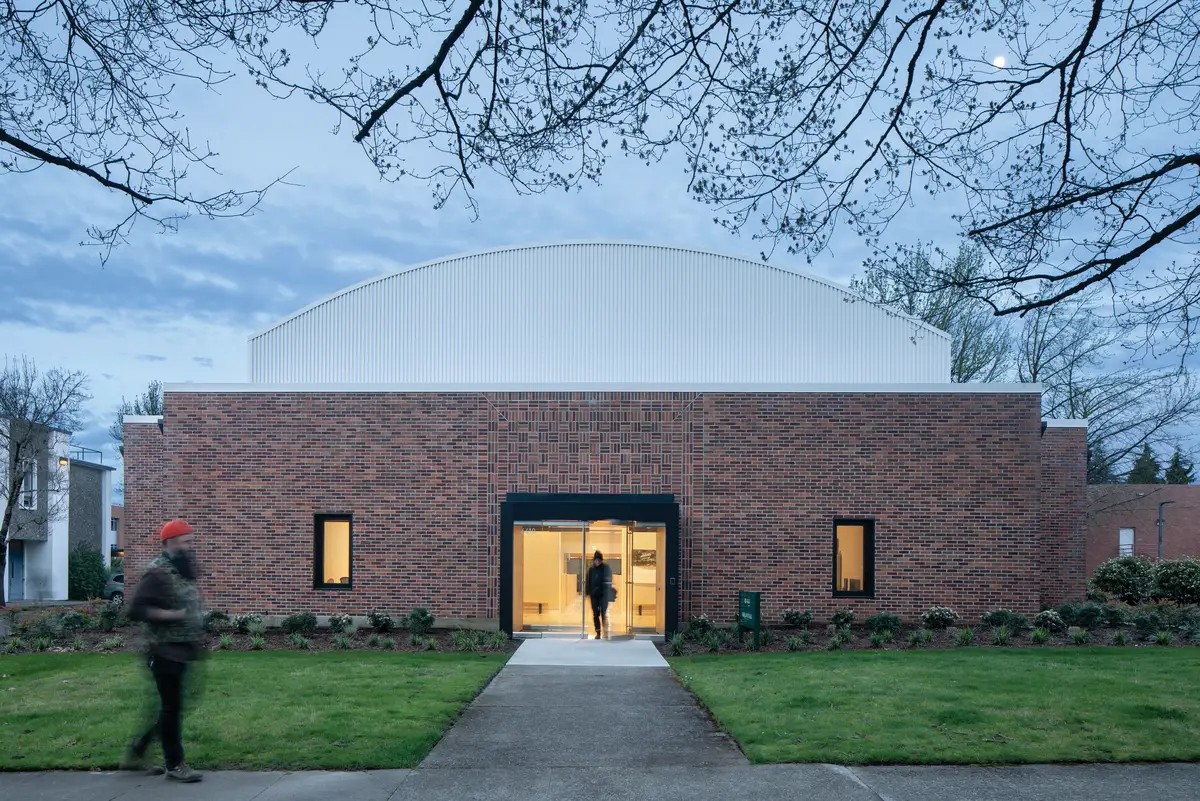
Photo © Lara Swimmer
Glazed entrances, and windows inserted into the brick facade (above), flood the interior with daylight (top).
WHEN the Eugene-based University of Oregon bought the defunct Concordia University to house its Portland campus in 2022, department directors had to puzzle their programs into a dozen mostly 1970s and ’80s-
era buildings. The College of Design’s Portland architecture school decided to take the building widely regarded as the runt of the litter: a 1950s gymnasium converted into a theater three decades ago. “Nobody really wanted it,” says Justin Fowler, director of UO Portland Architecture, but he and his colleagues saw potential.
UO tapped Portland’s Lever Architecture to transform the building. Upon first sight, the old gym-turned-theater’s proscenium stage, green rooms, and overall darkness, “reminded me of my junior high school auditorium,” says Lever founding principal Thomas Robinson. But when the team punched through the dropped ceiling and scraped away a patch of the floor’s black paint, a “diamond in the rough” emerged in rustic timber bow trusses, long-covered clerestory windows, and maple floors.
Now reclaimed and renewed, the program’s new home—called Highland Hall—is a study in reuse, restraint, and economy.
With a deadline of one year for design and construction and a tight budget, “we couldn’t afford to design too much,” Robinson says, “but we could spend a lot of time thinking about the design we were doing.”
At ground level, the 8,640 square-foot building was an almost windowless brick box, but also one of the few campus structures directly facing an adjacent residential neighborhood in Northeast Portland. With simple insertions of glass entries at each end, the unassuming midcentury structure now provides gracious front doors to the neighbors and the campus behind it while serving as a visual portal between them.
Lever replaced the boarded-over clerestories with a glazing system that bathes the space in sunlight. Eleven new ground-level windows provide additional light, anchor the interior experience to its surroundings, and, for the tiny faculty offices, offer a sense of greater space. Reversible fans and ceiling vents draw air in or expel it, to moderate temperatures.
Now exposed and steel-reinforced, the bowstring trusses shape a barrel-vaulted ceiling, 32 feet high at the peak. Seminar rooms, spaces for pinups, restrooms, and a kitchenette are neatly tucked into the perimeter. A gallery positioned just inside the front entrance buffers studios from faculty and provides a gathering spot for lectures and reviews. “We didn’t want to be hovering over the students,” Fowler says.
The most notable architectural insertion is a series of 7-inch-thick mass-plywood slabs that frame the vestibules around the front and rear entrances. They also serve as partial-height partitions to divide the four studios and enclose the seminar rooms. The slabs lived their first life as floor panels used for seismic testing by the TallWood Design Institute’s Emmerson Advanced Wood Products Laboratory at Oregon State University. Robinson discovered that an enterprising OSU student had catalogued the remnants. Testing stresses precluded any structural reuse, so he convinced the Institute to donate the materials and the cost of CNC machining. “We reused something that would have just been thrown away,” he says. Click here to read more....
This series covers wide-ranging strategies for a greener future, from circular and low-carbon materials and building adaptation to net zero energy and urban megadevelopments.
Photo © Romanin & Noceto
Waste brick developed for the Design Museum Gent by Carmody Groarke.
Select an article to read more.
By Tim Abrahams

Photo courtesy Carmody Groarke
Kevin Carmody (left) and Andy Groarke (right) founded their practice in 2006.
Although Kevin Carmody and Andy Groarke met during their time in David Chipperfield Architects’ London office in the early 2000s, they are more likely to cite one of his clients, Antony Gormley, as a mentor. While the pair were working on the sculptor’s new studio, he showed them how “materials take their form through processes and how these can determine the character of a project.” They founded their own practice in 2006, continuing to collaborate with Gormley thereafter on a range of works. Two other early projects embedded the importance of material lifespan in their subsequent work: Studio East Dining was a striking temporary restaurant at the heart of the emerging Olympics Park in 2010, made from building-site materials such as scaffolding boards and poles, which were returned to their original use after three weeks. By contrast, their memorial to the July 7 terrorist attacks in Hyde Park in London was made from stainless-steel cast vertical pillars and was built to last for 300 years.
Carmody Groarke is known in London for its stylish, low-budget adaptations of existing buildings, which give, says Groarke, “an experience of architecture through the way that it is made.” For example, the aluminum-clad extension of a simple warehouse in Bethnal Green, which mirrors the floors below, is a visual manifesto for reusing the city’s industrial structures imaginatively. However, the firm’s most interesting work has operated at the two extreme poles of lifespan established by its early projects. The Hill House Box is a temporary superstructure that protects Hill House, a key Charles Rennie Mackintosh work near Glasgow, that members of the public can access to closely view the historic building during restoration and renovation. The office has also been working on a long-term master plan for the British Library. record contributor Tim Abrahams speaks with Andy Groarke about the practice’s thoughtful approach to the life of construction materials.

Photo © Johan Dehlin
Hill House Box is unusual in allowing visits by members of the public during active conservation as one of Charles Rennie Mackintosh’s most significant works is being restored.
Tell me about the new building at Boston Spa for the British Library, which is expected to be completed next summer.
Around 80 percent of the library’s collection is stored in Yorkshire, in buildings that were originally part of a WWII munitions plant. The last facility, built in the 1970s, used conventional architecture based on retrieving books off shelves by hand. The new building is a fully automated storage facility. In a single room the size of a soccer pitch and about 10 stories high, 8 million books will live.
Where is the architecture in such a building?
We thought about trying to find ways in which the architecture could help not only environmental sustainability, but the long-term institutional sustainability of the British Library by creating an archive building that was as passive as possible.
We are nearing completion, and the tests are telling us it’s one of the most airtight buildings in Europe, so we can neutralize risks to the collection by de-oxygenating the environment to the same air quality of Base Camp Two on Mount Everest—quite difficult to breathe in, but it almost eradicates the risk of fire. The environmental engineers have worked out that the collection itself can create thermal stability, meaning that the energy use of the building is only around 3 percent of the energy use of the last storage building the British Library built.
What is it like to be inside it?
You get this otherworldly space of robots and books at a scale that, at first sight, you can’t get your head around. We find that a tremendously interesting spectacle. Click here to read more....
The University of Oregon’s architecture program transforms a disused 1950s gym into its Portland home
By Randy Gragg

Photo © Lara Swimmer

Photo © Lara Swimmer
Glazed entrances, and windows inserted into the brick facade (above), flood the interior with daylight (top).
WHEN the Eugene-based University of Oregon bought the defunct Concordia University to house its Portland campus in 2022, department directors had to puzzle their programs into a dozen mostly 1970s and ’80s-
era buildings. The College of Design’s Portland architecture school decided to take the building widely regarded as the runt of the litter: a 1950s gymnasium converted into a theater three decades ago. “Nobody really wanted it,” says Justin Fowler, director of UO Portland Architecture, but he and his colleagues saw potential.
UO tapped Portland’s Lever Architecture to transform the building. Upon first sight, the old gym-turned-theater’s proscenium stage, green rooms, and overall darkness, “reminded me of my junior high school auditorium,” says Lever founding principal Thomas Robinson. But when the team punched through the dropped ceiling and scraped away a patch of the floor’s black paint, a “diamond in the rough” emerged in rustic timber bow trusses, long-covered clerestory windows, and maple floors.
Now reclaimed and renewed, the program’s new home—called Highland Hall—is a study in reuse, restraint, and economy.
With a deadline of one year for design and construction and a tight budget, “we couldn’t afford to design too much,” Robinson says, “but we could spend a lot of time thinking about the design we were doing.”
At ground level, the 8,640 square-foot building was an almost windowless brick box, but also one of the few campus structures directly facing an adjacent residential neighborhood in Northeast Portland. With simple insertions of glass entries at each end, the unassuming midcentury structure now provides gracious front doors to the neighbors and the campus behind it while serving as a visual portal between them.
Lever replaced the boarded-over clerestories with a glazing system that bathes the space in sunlight. Eleven new ground-level windows provide additional light, anchor the interior experience to its surroundings, and, for the tiny faculty offices, offer a sense of greater space. Reversible fans and ceiling vents draw air in or expel it, to moderate temperatures.
Now exposed and steel-reinforced, the bowstring trusses shape a barrel-vaulted ceiling, 32 feet high at the peak. Seminar rooms, spaces for pinups, restrooms, and a kitchenette are neatly tucked into the perimeter. A gallery positioned just inside the front entrance buffers studios from faculty and provides a gathering spot for lectures and reviews. “We didn’t want to be hovering over the students,” Fowler says.
The most notable architectural insertion is a series of 7-inch-thick mass-plywood slabs that frame the vestibules around the front and rear entrances. They also serve as partial-height partitions to divide the four studios and enclose the seminar rooms. The slabs lived their first life as floor panels used for seismic testing by the TallWood Design Institute’s Emmerson Advanced Wood Products Laboratory at Oregon State University. Robinson discovered that an enterprising OSU student had catalogued the remnants. Testing stresses precluded any structural reuse, so he convinced the Institute to donate the materials and the cost of CNC machining. “We reused something that would have just been thrown away,” he says. Click here to read more....
A mixed-use development aims for environmental and social responsibility on a grand scale
By Matthew Allen
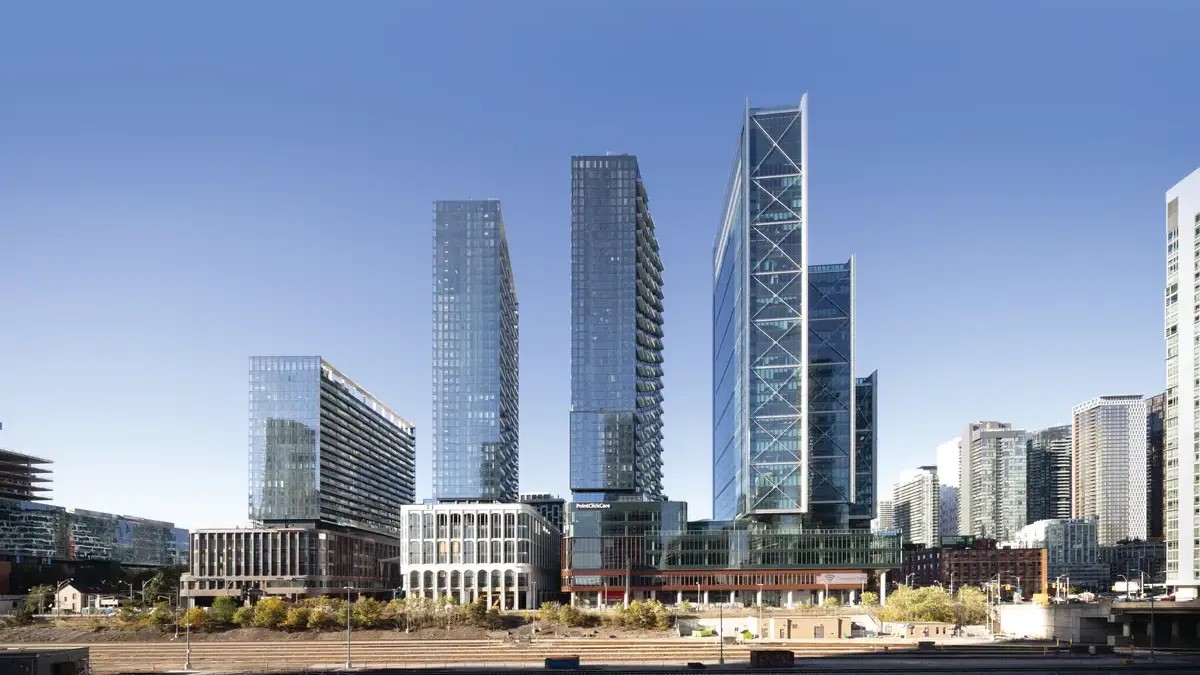
In its best new megaprojects, Toronto has developed a distinct approach to urbanism that aims for environmental and social sustainability, but the characteristic modesty of local architects sometimes makes their city-building style difficult to see. This conundrum is epitomized by The Well, a 3 million-square-foot mixed-use development just completed at the edge of downtown, which involved six architects from Toronto and beyond. One office tower, three residential towers, and three stepped residential volumes sit atop seven chunky masses, all calibrated to fit the site’s many different adjacencies.
The civic importance of the development required careful negotiation among the players involved and added further complexity. The eight-acre site along Front Street—up until the 1850s, a waterfront promenade—was vacated by the Globe and Mail newspaper in 2016 following acquisition of the property in 2012 by a partnership of the real-estate investment trusts RioCan and Allied and the developer DiamondCorp. It was a rare large plot next to the financial district and along a major thoroughfare. “Potentially a once-in-a-career opportunity,” says Andrew Duncan, chief investment officer of RioCan.
The vision for the site was settled in 2014 by a master-planning team of Hariri Pontarini—a Toronto-based architecture practice founded in 1994 by Siamak Hariri and David Pontarini—plus the Montreal-based landscape architect Claude Cormier and the Toronto planning firm Urban Strategies. Early renderings promised a combination of mid- and high-rise, old and new, commercial and residential to bridge the divide between downtown and the surrounding neighborhood. In the architects’ site model, slabs of walnut established a roughly five-story datum matching nearby mid-rise buildings, with paper and plexiglass extrusions meant to echo the skyline of the financial district to the east. A pedestrian zone cutting through the center of the site completed the parti. “Blocks in this area were zoned industrial and are some of the biggest in the city,” says Michael Conway, Hariri Pontarini associate partner. “We wanted to make it porous by connecting to the alleyways of the neighborhood, and create the potential for discovery—like finding a hidden nightclub.”
Since then, all eyes in the city have been on the intersection of Front and Spadina Avenue. The Well is the most prominent of Toronto’s many current mega-projects. Its location is only half the reason. Just down the street is Fort York, where Americans achieved a pyrrhic victory in 1813. The other way is Union Station, and across the below-grade rail yard alongside Front Street is the most conspicuous development of a previous boom, CityPlace. The other half of the reason for The Well’s notoriety—at least among urbanists—is this juxtaposition. Completed between 2003 and 2020, CityPlace’s expanse of 30 residential towers on 45 acres with only 200,000 square feet of retail is functionally homogenous, and it often feels bereft of life. In comparison, The Well’s 320,000 square feet of retail on a site less than a fifth the size practically guarantees an energetic bustle.
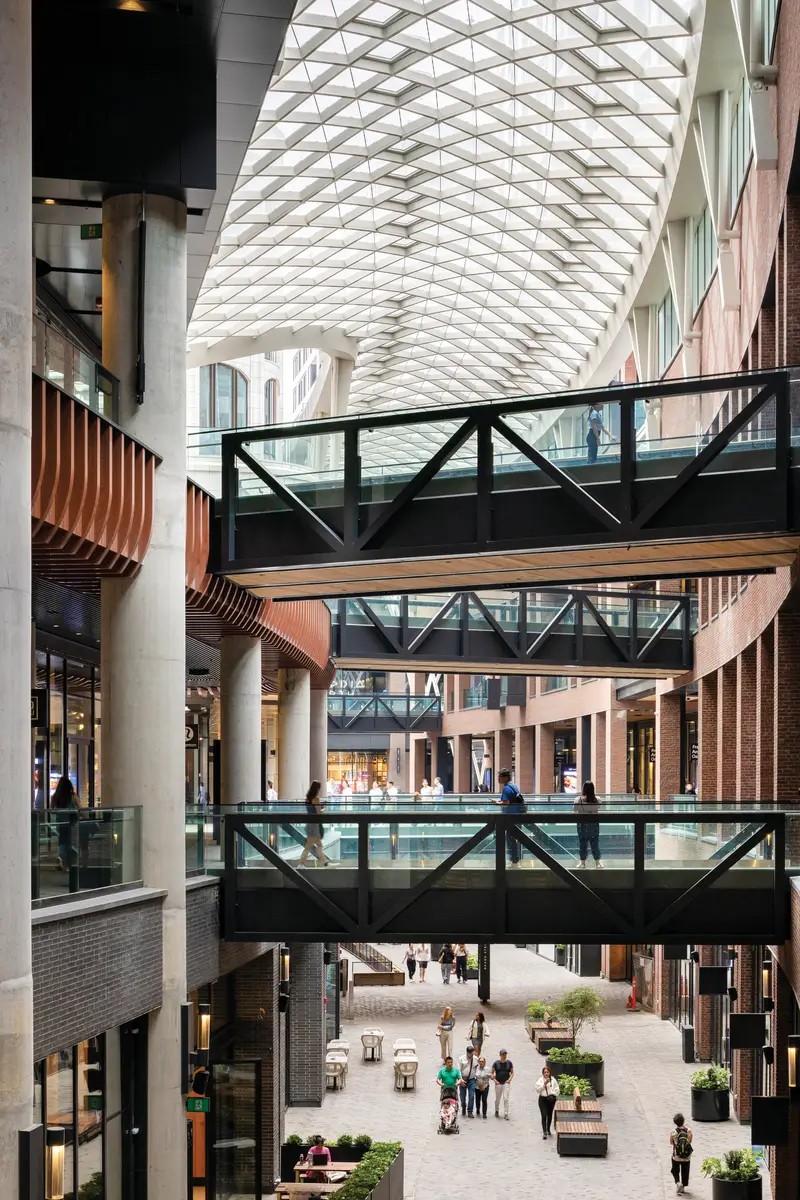
Photo © BDP / Nick Caville
A shopping street covered by a glazed canopy connects the towers at ground level.
The Well could easily have become a shopping island. Peering east, a stadium, an arena, and a convention center are all within walking distance—but close is still too far away for retail. Is The Well sufficiently enticing to draw in the crowds ambling home after a Jays game? The project’s big move is to open cavernously at the corner. Escalators invite pedestrians both up and down to shops and eateries in a three-story midblock atrium capped by a glass-and-steel canopy. The whole thing is open-air—in a big way at the three endpoints of its overall T shape, and through alley-like passages along the way. It’s not a mall, typologically, and not a shopping street either, but a distinct urban retail type fitting Toronto’s climate and population. Though not conditioned, a pleasant breeze cuts through the canopied atrium in the summer. In the winter, “you can unzip your parka, but you don’t need to take it off,” remarks Adrian Price, a principal at BDP, the British firm that designed the canopy and the retail environment. BDP has experience with similar spaces—for instance at Westgate in Oxford, England—but such glass-covered atria are also a Toronto specialty: the largest downtown mall is covered with one, and so is a nearby galleria by Santiago Calatrava. Click here to read more....
